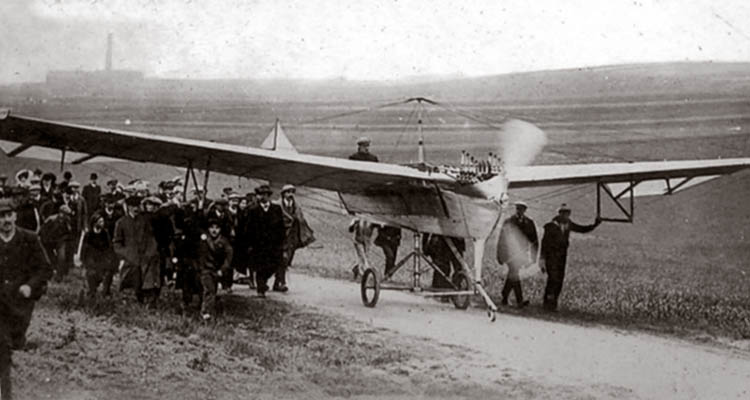On the morning of July 12, 1909, a group of men struggled against the wind, wrestling tarpaulins into a makeshift tent at Sangatte, five miles west of Calais on the French coast. Despite the unseasonably cold, rainy and blustery weather, no one was discouraged. They were far too focused on preparing for what they hoped would be a historic flight across the English Channel.
The tent, attached to an abandoned building, would serve as a hangar for a stunning French aircraft, the Antoinette IV monoplane. On hand were pilot Hubert Latham, designer-engineer Léon Levavasseur, engineer Charles Wachter, Jules Gastambide and five mechanics. Levavasseur was the co-owner, with Gastambide, of a company known as Société Anonyme d’Antoinette, which had manufactured the plane.
Despite the miserable weather, curious onlookers began arriving at the camp, motoring or cycling to the coast to see what all the fuss was about. What started out as a small group swelled to huge numbers when word got around that Latham intended to try for the Daily Mail prize of £1,000. The prize would be awarded to the first individual who succeeded in flying from England to France, or vice versa, under the following conditions: The flight must be made between the hours of sunrise and sunset; it was to be accomplished by a heavier-than-air craft that was not supported by gas or any other substance confined within the machine; and no part of the airplane could touch the sea during the crossing.
Newspaper owner Alfred Harmsworth, better known as Lord Northcliffe, had offered the prize in October 1908, originally for £500. When there were no takers by February 1909, he doubled the amount. He was determined to give the British government, or at least his fellow countrymen, a kick in the pants to stimulate more interest in the new science of aviation. Lord Northcliffe felt, not without good reason, that England was woefully behind France and the United States. He really wanted an Englishman to fly the Channel first, but he knew if a Frenchman or an American won the prize, it would go a long way toward getting his own lethargic government “off the shilling,” so to speak.
It was generally assumed throughout Europe that one of the Wright brothers would be the first to make a cross-Channel attempt. Prior to Wilbur’s flights at Le Mans and elsewhere in France in September and October of the previous year, the French had believed that the Wrights’ accomplishments on the other side of the Atlantic were wildly exaggerated, blown out of proportion by a jingoistic American press. But Wright’s demonstrations in France stunned the French, and in fact the entire world. He dipped, swirled, performed figure eights, carried a passenger aloft with him and managed to stretch out some of his flights for an unbelievable 45 minutes or longer. Who else, therefore, would dare attempt to fly over the English Channel, a 26-mile flight that would take 30 to 40 minutes?
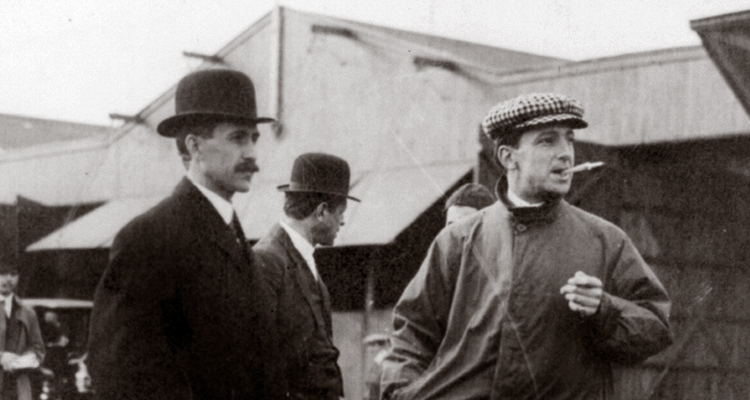
But Wilbur Wright was in France to sell his biplane, preferably to the French government, and to find a local manufacturer who could build it under license for European clients. Prizes and competitive flying didn’t interest the Wrights in the least. Although their aircraft performed admirably at many of the aviation meets that commenced in August 1909 (the first at Reims), neither brother was ever an entrant. Another pilot, invariably a Frenchman, always piloted the Wright plane on these occasions.
Hubert Latham, who would attempt the cross-Channel flight on behalf of Société Anonyme d’Antoinette, was hardly a household name in France at the time. As for the Antoinette’s designer, Léon Levavasseur, he was a bona fide genius. He had been an electrical engineer by trade, but engines were his true passion. In 1903 he co-founded the Société with business entrepreneur Jules Gastambide, for whom he had once worked as manager of his electrical parts factory in Algeria. Within two months of the company’s formation, Levavasseur designed, on paper at any rate, a V-8 gasoline engine that would become the first patented motor of its kind in the world. His engines fared poorly in automobiles but proved hugely successful in powerboats, devouring the competition in the winter races off Monaco’s coast.
Thanks to its splendid power-to-weight ratio, the Antoinette engine (named after Gastambide’s daughter) soon became sought after as an aircraft power plant. In fact, its creation proved to be the turning point for the company. Many of the early French aviation giants—Henry Farman, Robert Esnault-Pelterie, Louis Blériot, Gabriel Voisin, Alberto Santos-Dumont and several others—used the motor to power their aircraft. For all intents and purposes, up to early 1909 the Antoinette V-8 was the workhorse of French aviation.
Levavasseur eventually convinced the Société’s board of directors to authorize him to design and build his own aircraft. The board members were initially reluctant, believing they already had a gold mine in their engine, and unwilling to risk investing in the manufacture of an airplane. Like Blériot, Levavasseur was convinced that the only aircraft worth building was a monoplane (Blériot himself had served part-time as an officer and engineer with the Société, but when the company decided to build monoplanes, he quit in a pique and returned full-time to his own company). Thus in 1908, after many prototype models had ended in failure, was born the Antoinette monoplane, arguably the finest aircraft of its day, and certainly the most beautiful and elegant plane then extant.
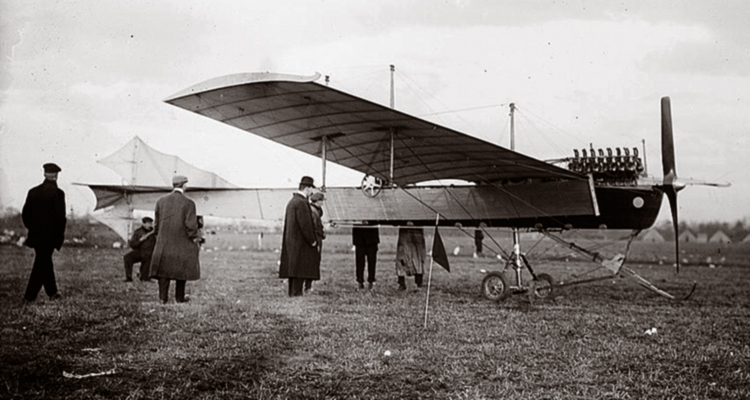
Levavasseur’s design incorporated France’s first fuel injection system and a novel evaporative cooling system in the new plane’s engine. It was this cooling system that enabled the motor to weigh so little, yet still develop 50 hp. But was the plane controllable? Was it stable? Would it be competitive?
Test flights by company pilots Eugéne Welféringer and René Demanest were not encouraging. While the Antoinette flew reasonably well, it was the very devil to keep under control, given its complicated system of four separate control wheels and two foot pedals. Moreover, landing was always a suspense-filled event. Before long the Antoinette developed a reputation as a pilot killer, even though no pilot had as yet been killed or even seriously injured in it.
Levavasseur had enormous faith in his design and decided that he only needed the right pilot to tame the beast. In early 1909 he settled on Latham, a cousin of Gastambide’s who had driven a few of the company’s boats to victory five years earlier.
Arthur Louis Hubert Latham had witnessed Wilbur Wright’s demonstrations at Le Mans and, in search of new adventure, decided on the spot that flying was for him. The fact that the aristocratic Latham offered to invest some of his family money in the Société no doubt greased the wheels. Now all that remained was to determine whether he could learn to fly. He told Levavasseur: “I’ll fly your machine, Léon, and if I break it, you repair it. And I’ll keep on breaking it until it flies, or it gets me.”
At first “breaking the machine” is just what Latham did, many times over, invariably on landing. But within two months he had mastered its complex control system and demonstrated that he was a talented pilot. Levavasseur had at last found his ace.
In early June 1909, Latham broke the world record for monoplane flight time by remaining in the air for an astonishing 67 minutes. A week later he won the Prix Goupy by flying a six-kilometer straight course in the fastest time. He then made a demonstration flight in a stiff breeze, showcasing the Antoinette’s inherent stability.
Those successes convinced Levavasseur that Latham should try for the Daily Mail prize. Gastambide agreed, and their only remaining Antoinette IV (sales had by then depleted their stock) was dismantled and shipped by train from their factory, just outside Paris, to Calais, and thence by horse and cart to Sangatte, arriving on July 11.
The man who would pilot the Antoinette IV in its historic Channel-crossing attempt was a peculiar person. In the words of Harry Harper, a Daily Mail aviation writer, Latham “was a very difficult man to truly like—moody one day, gay the next.” He had a quick temper and sulked when he didn’t get his way. Although Latham became one of the most skilled pilots of his era, he was also very cautious. He took chances—what flier didn’t in those days?—but he was no daredevil. He inspected every inch of his mount before taking off, making sure each screw, fastener and wire was tight and there was no damage to the fuselage, propeller or wings. Once he took to the air in the beautiful Antoinette, however, Latham’s gallant demeanor and trademark checked hat and cigarette ensured that he became one of the most popular men in France. A German newspaper proclaimed him one of the three most eligible bachelors in Europe.
To Levavasseur, an airplane’s appearance was every bit as important as its performance, not surprising given that he was an avid sculptor and painter. His Antoinette was truly a testament to engineering genius allied with artistic flair. The plane was so meticulously crafted that many thought it belonged in a museum. The hours of labor required to construct it represented up to 10 times that needed for other airplanes of the day. The effort demanded skilled artisans of several disciplines, along with special preparations and tools, driving production costs ever higher.
Ash and spruce were used for the individual moldings, many of them bent with steam for more attractive lines, and only expensive red cedar was employed for the front fuselage paneling. The cedar veneer panels were fastened with burnished copper nails, which were polished with glass sandpaper and pumice stone for maximum smoothness. Then several coats of oil, each a different grade, were applied, and the panels got three or four coats of glistening varnish to make them impervious to moisture and to cut down on air resistance. The wings and fuselage, aside from the cedar panels and copper cooling tubes just behind the engine, were covered with rubberized linen developed by Dunlop Tire in England. No expense was spared to ensure that the plane combined superior agility with great strength.
Levavasseur was justifiably proud of his design. He gloated over one reporter’s comments about the Antoinette’s performance at the Reims aviation meet: “Down the hill sailed the Antoinette with the perfect precision and grace of a bird’s flight…like a giant dragonfly skimming with iridescent wings through the summer air. Just as it took its flight the sun broke through and made its white, varnished skin shimmer in a golden haze.”
Latham’s languid demeanor and cool hauteur, combined with the Antoinette’s regal bearing, made for performances never to be forgotten. No other competitor, not even other Antoinette pilots, in all the aviation events in France from August 1909 through June 1911 drew applause nearly every time his airplane passed in front of the grandstands.
Latham did have at least one early competitor for his Channel attempt, a Russian-born count with French citizenship, Charles de Lambert, who had studied with Wilbur Wright at his school in Pau, France. The count decided he would pilot his own Wright Flyer and go for the prize. But when de Lambert repeatedly experienced engine trouble and crashed on a practice flight, badly damaging his plane, he gave up on the competition.
Once the Antoinette had been reassembled at Sangatte, all that held Latham back was the weather. One miserable day followed another until July 18, when it was finally clear enough for a practice run. Levavasseur intended Latham to make a short flight, land, refuel and then go up for a longer flight, staying aloft for at least 45 minutes. Latham flew for several minutes, but then crashed on landing. Fortunately only a wheel strut had been damaged, and it was easily fixed.
By the time repairs were completed, however, the weather had worsened, and Latham was unable to get in his critical second endurance flight. Levavasseur, generally cautious when his inventions were on display, astounded the Antoinette camp by announcing that Latham was ready to make his Channel attempt, perhaps even the next day. Apparently the designer, tired of waiting, was willing to forego the second test flight.
Harpon, a French torpedo-destroyer, would accompany Latham as far as possible. Another logistical detail for the Antoinette team involved fine-tuning the Marconi wireless system. The Daily Mail’s reporter Harry Harper, who was not about to miss one second of this momentous event, had arranged to receive weather reports from Dover, England, which would be another historic first.
That night, after performing some static tests on the Antoinette’s engine, Levavasseur and the rest of the crew went back to their hotel in Sangatte. Disdaining that modest establishment, Latham opted to drive to Calais, where he stayed at the city’s finest hotel.
Given his boundless confidence in his own skills, Latham was probably the only member of the team who got much rest that night. Levavasseur dreaded the thought that his airplane might fail, and Gastambide was worried what failure might mean for the company. Everyone was concerned for Latham’s safety. Navigation methods at that time were primitive, to say the least, and it was easy to envision the aviator unwittingly drifting too far eastward and missing the English coast altogether, then crashing into the North Sea when his fuel gave out. Were that to happen, there was little chance the pilot would ever be found.
The 19th dawned misty and calm. Harper listened to weather reports from Dover on his wireless and reported that they seemed favorable. Levavasseur rushed to Calais to rouse Latham, then boarded Harpon to be close by during the flight. Latham climbed into the plane as soon as he reached Sangatte. To get to the takeoff point, Cap Blanc Nez, 11⁄2 miles away, a team of horses towed the Antoinette partway, then it taxied under its own power the rest of the distance. Hundreds of onlookers had gathered by that time, along with reporters and photographers. Harper contacted Dover and alerted the British that Latham was about to take off.
Harpon, meanwhile, had left the harbor and was about two miles offshore, where it took up station, steaming in great circles. At 6 a.m. the crew fired the ship’s guns, signaling that it was in position.
A half-hour after Harpon’s signal, Latham climbed into the cockpit and signaled his crew to crank the propeller. The engine coughed a few times and then caught, belching out billowing clouds of blue-black smoke. The flier fiddled with the throttle, alternating between gunning and backing off the engine. Satisfied, he finally yelled out to the mechanics anchoring the plane to let go.
The Antoinette lurched forward, moving ponderously at first, but soon gathered sufficient speed to soar into the air over the bumpy field. The awed crowd cheered and applauded as the beautiful aircraft rose above them.
Latham circled the field several times, climbing until he reached 1,000 feet, an incredible height for that era (a month later he would set a world altitude record at Reims of just 506 feet). He headed out over the cliffs of Cape Blanc Nez for his destination—a field atop Shakespeare Cliff, just outside Dover.
But Latham’s departure a full 30 minutes after Harpon’s signal had worried the ship’s captain. To him, his signal was supposed to have served the twofold purpose of letting Latham know that the boat was ready and that he should take off immediately.
Fearing that Latham might already have crashed into the sea short of where Harpon was then waiting, the captain turned his ship and started to head back toward port—only to have Latham overtake him, traveling in the opposite direction. But in the time it took Harpon to turn 180 degrees, Latham was not only out of sight, he was in the water.
The next 10 minutes of Latham’s adventure were later described by Flight magazine:
If in the whole gamut of human sensations there is anything more likely to bring one’s heart into one’s mouth than the sudden misfiring of one’s engine while aboard a flyer a thousand feet above the sea, I should like to know of it. In Latham’s words, “I examined all the electrical connections that were within my reach. I could hear that more than one of the eight cylinders were misfiring. It was maddening, but I was helpless. I came down not in a series of short glides, but in one clean straight downward slope. My speed at the moment of impact was about 40 or 45 miles an hour. The machine was under perfect control during descent; instead of diving into the sea at an angle I skimmed down so that I was able to make contact with the sea with the aeroplane practically in a horizontal position. It settled on the water and floated like a cork. I swung my feet up onto a cross bar to prevent them from getting wet. Then I took out my cigarette case, lit a cigarette, and waited for the torpedo-destroyer to come up. There was nothing else to be done.”
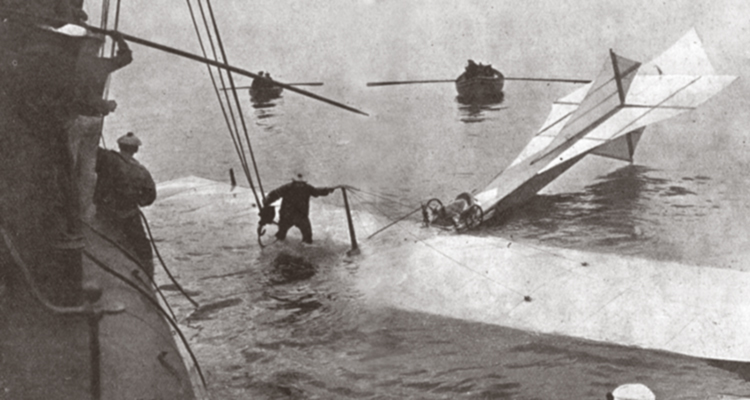
What went wrong? No one knows for sure. Wilbur Wright, who had toured the Antoinette factory earlier that year and inspected the engines, was sure the fuel injection system would prove unreliable in humid conditions and thought that Levavasseur should have relied on standard carburetors, at least when flying over open water. On the other hand, René Thomas—who soon thereafter began working for the Antoinette company as a mechanic and later became a pilot—was convinced that the engine had failed because Levavasseur had not filtered the fuel. Given the narrow jets of the engine’s fuel injection system, that could have been a critical problem.
Levavasseur himself, not one to admit mistakes, was certain the problem had arisen when the plane was transported down the bumpy road to its takeoff point. He assumed some critical piece of the engine must have shaken loose while the plane was on the ground and then become detached during the flight.
To Levavasseur’s dismay, the attempt to salvage the aircraft, which had been virtually undamaged when it went into the water, degenerated into a comedy of errors. The plane was a wreck by the time it arrived in Calais. Lashed to the side of Harpon awaiting transfer to a tug, it broke apart. The hoist operator was to blame, having failed to consider that the fuselage was full of seawater that shifted to both ends, putting an impossible strain on the framework. Adding insult to injury, souvenir hunters in Calais got to the airplane before Levavasseur and stripped it of anything not bolted or screwed down.
Though he was angry when he learned of the Antoinette’s fate, Levavasseur nevertheless retained the presence of mind to dispatch Latham to Paris to superintend the shipment of another airplane, this time his newest model, the Antoinette VII, for a second Channel attempt. At that point, however, the new plane had not even been test flown.
While Latham was en route to Paris, Levavasseur held a press briefing, hiding his dismay over Latham’s failure and the plane’s destruction. Looking the reporters straight in the eyes, he said: “Gentlemen, look just for a moment here. The Antoinette’s engine’s failure was just an accident. Just that. Why, even horse carts can fail too, you know? What is important is that I have developed a machine that can go on land, in the air, and in the water. It runs, it flies, it swims. C’est un triomphe!”
But the next day Levavasseur’s old nemesis, Louis Blériot, formally entered the competition. On July 25, with an amazing display of courage and determination laced with a generous helping of luck, Blériot took advantage of a brief period of early morning good weather to succeed in his Blériot XI monoplane where Latham had failed. Taking off from a spot near Calais at 4:41 a.m., Blériot landed near Dover Castle just 36 minutes later, at 5:17. Latham missed out on that fleeting opportunity because no one on the Antoinette team awakened him early enough to make a flight that day.
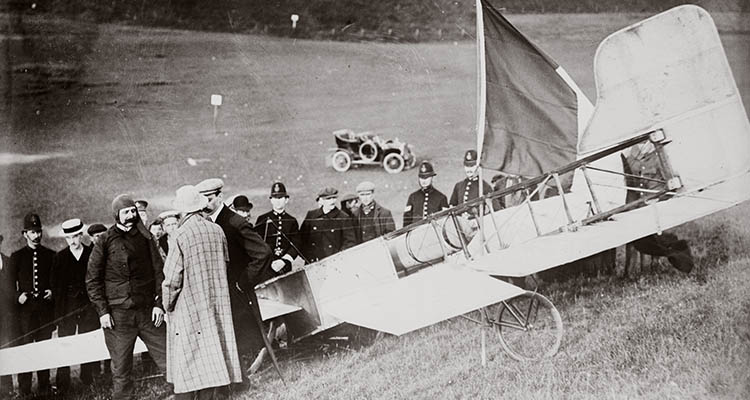
Latham did make a second attempt on July 27, but again met with disaster, this time going down only 11⁄2 heartbreaking miles from Dover. Once more he had been defeated by a malfunctioning engine.
Oddly enough, Latham’s spectacular failures enhanced rather than detracted from his public image. The picture of him perched in the cockpit of the stricken Antoinette, serenely smoking a cigarette while waiting to be picked up by a rescue boat, was carried in practically every newspaper around the world. He became an instant celebrity—an authentic hero not just for what he had tried to accomplish but also for how he had faced defeat. Latham’s grand effort was indeed a failure twice over, but that was not how the French saw it. The image of a manor-born French gentleman, filled with pluck and sang-froid, attempting the Channel crossing in a gorgeous French-built plane, transformed the whole episode into a national triumph.
While another, better-known Frenchman had garnered the Daily Mail prize, Latham emerged from that competition imbued with star appeal. In the months that followed, he competed in aviation meets in Europe as well as the United States, set several world records and thrilled audiences everywhere. But he never again challenged the Channel.
Two years later, Latham announced that he was tired of competitive flying. He left on a hunting trip to Africa in December 1911. According to some accounts, he may have been suffering from tuberculosis. In June 1912, he died, reportedly killed by an enraged buffalo that he had wounded.
Latham was once again in the news two years after his death. An article appeared in the newspaper Journal du Havre, stating that the commandant of a French colonial army garrison in present-day Chad had believed, after examining Latham’s body and the scene, that there was strong evidence of foul play, and speculated that Latham might have been murdered by one or more of his bearers. As the commander had not been able to prove his suspicions at the time, he soon terminated his investigation. Why that information took almost two years to surface in the press is unknown.
Sadly, the world quickly forgot the Antoinette pilot. While Blériot’s planes and flying exploits are remembered around the world today, few have ever heard of Hubert Latham, who faced two highly publicized failures with Gallic aplomb, and managed to transform embarrassing washouts into star status.
Stephen H. King is a retired U.S. foreign service officer whose wife is a distant cousin of Hubert Latham’s. He based his historical novel Wind-killer on the last three years of Latham’s life. For additional reading, try King’s nonfiction The Passion That Left the Ground. See www.lathamlevavasseur.com.
This article by Stephen H. King was originally published in the November 2007 issue of Aviation History Magazine. For more great articles, subscribe to Aviation History magazine today!

